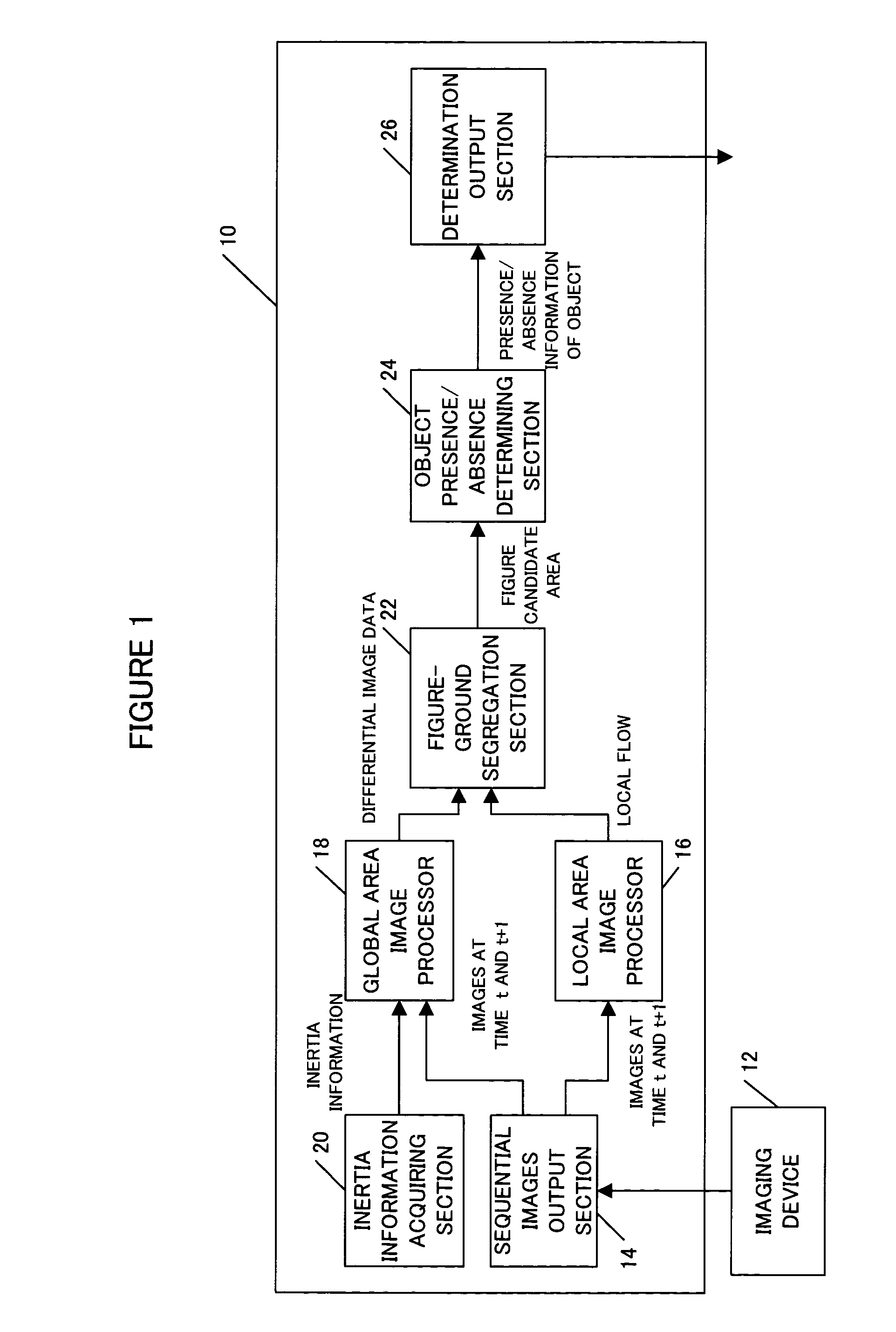Image-based object detection apparatus and method
a technology of object detection and object detection, applied in the field of image-based object detection apparatus and method, can solve the problems of difficult separation of background optical flow of stationary objects from optical flow of stationary objects, inability to accurately detect stationary objects, and difficulty in accurately detecting moving objects in images. to achieve the effect of improving the accuracy of object detection
- Summary
- Abstract
- Description
- Claims
- Application Information
AI Technical Summary
Benefits of technology
Problems solved by technology
Method used
Image
Examples
first embodiment
of the Invention
[0043]FIG. 1 shows a block diagram of an object detection apparatus according to the first embodiment of the invention. The object detection apparatus 10 receives sequential images in the direction of travel which are captured at predetermined time intervals by an imaging device 12, such as a CCD camera, mounted on a mobile unit such as an autonomous traveling vehicle. The device 10 then determines a presence / absence of an object in the image and outputs a determination result. The result signal may be supplied to a motor or a steering wheel of the mobile unit to steer around the object blocking the pass of the mobile unit. Alternatively, the result signal may be notified to passengers on the mobile unit like an autonomous vehicle or to external to the mobile unit.
[0044] The object detection apparatus 10 may be implemented by, for example, a microcomputer having at least a CPU for executing various computations, a memory for temporarily storing computation results, ...
second embodiment
of the Invention
[0074]FIG. 9 is a block diagram of an object detection apparatus 100 according to second embodiment of the invention. A sequential images output section 114, a local area image processor 116, an inertia information acquiring section 120, an object presence / absence determining section 124 and a determination output section 126 are same with corresponding function blocks of the first embodiment. Process in a global area image processor 118 and a figure-ground segregation section 122 is different from the corresponding process in the first embodiment. In contrast to the first embodiment, there is feedback from the figure-ground segregation section 122 to the global area image processor 118. Therefore, only processes in the global area image processor 118 and the figure-ground segregation section 122 will be described below with reference to flowcharts in FIG. 10.
[0075] Process in steps S130 to S134 is same with steps S50 to S54 in FIG. 6. Global flows estimated in step...
third embodiment
of the Invention
[0084] In this embodiment, a mobile unit carrying an imaging device 12 travels an environment in advance for detecting objects, captures images in the direction of motion and constructs a self-motion predictive space described below (hereinafter this process is referred to as “learning”.) When the object detection is executed, past image and present image are projected onto the self-motion predictive space and reconstruct them to create a predictive image.
[0085]FIG. 12 is a block diagram showing an overall configuration of an object detection apparatus 200 according to the third embodiment. Except for a global area image processor 218, process in each corresponding functional block is same with those of the object detection apparatus 10 according to the first embodiment shown in FIG. 1. Hereinafter process in the global area image processor 218 will be described with reference to FIGS. 13 and 14.
[0086]FIG. 13 is a flowchart in learning process. The global area imag...
PUM
 Login to View More
Login to View More Abstract
Description
Claims
Application Information
 Login to View More
Login to View More - R&D
- Intellectual Property
- Life Sciences
- Materials
- Tech Scout
- Unparalleled Data Quality
- Higher Quality Content
- 60% Fewer Hallucinations
Browse by: Latest US Patents, China's latest patents, Technical Efficacy Thesaurus, Application Domain, Technology Topic, Popular Technical Reports.
© 2025 PatSnap. All rights reserved.Legal|Privacy policy|Modern Slavery Act Transparency Statement|Sitemap|About US| Contact US: help@patsnap.com



